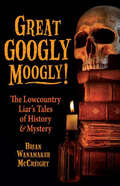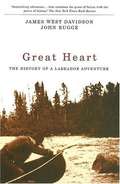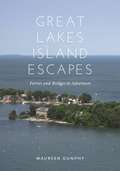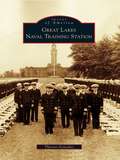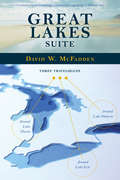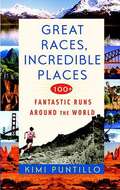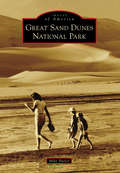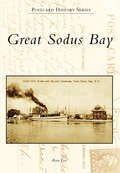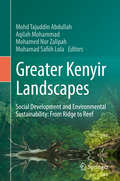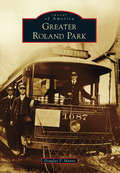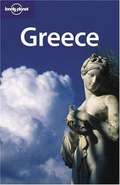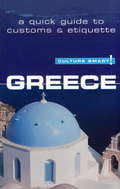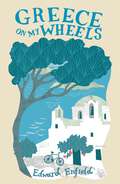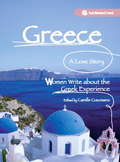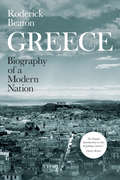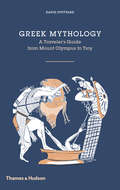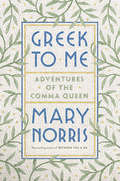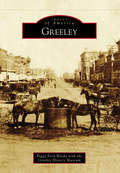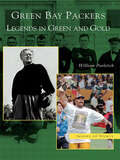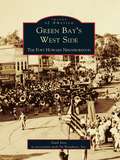- Table View
- List View
Great Googly Moogly!: The Lowcountry Liar's Tales of History & Mystery
by Brian Wanamaker McCreightStories based upon traditional South Carolina local history and legends fill the pages of this haunting collection. Talented wordsmith Jim Aisle, known as the Lowcountry Liar, spins tales of the supernatural, the weird, the mysterious, and the humorous. These titillating tales are recorded and relayed to the gentle reader by his friend Brian Wanamaker McCr�ight, who tosses in a few of his own yarns to round out this clever collection.Each story begins with a folksy introduction from both the Lowcountry Liar and McCr�ight as they ramble about the region and ends with notes about provenance and fascinating facts. The tales have a life of their own and will resonate with all who have listened in rapt attention around a campfire surrounded by darkness. Included are ghostly legends from the great Late Unpleasantness, more often referred to as the Civil War, with such intriguing titles as "The Silverware Civil War" and the "Cross of St. George." Spooky twists abound in "Love Stinks" and "Mother's Milk." Even the most endearing of timeless tales, such as the popular "The Little White Dog of White Point Garden," are told in the Lowcountry vernacular and will become a favorite of every reader.
Great Heart: The History of a Labrador Adventure
by Bill Mckibben James West Davidson John RuggeIn July 1903 Leonidas Hubbard set out to explore the uncharted interior of Labrador by canoe, accompanied by Dillon Wallace, his best friend, and George Elson, a M?s guide. Bad luck and bad judgment led the expedition into disaster and the party was forced to turn back. Hubbard died of starvation just thirty miles from camp.
Great Lakes Island Escapes: Ferries and Bridges to Adventure (Painted Turtle)
by Maureen DunphyThe Great Lakes Basin is the largest surface freshwater system on Earth. The more than 30,000 islands dotted throughout the basin provide some of the best ways to enjoy the Great Lakes. While the vast majority of these islands can only be reached by private boat or plane, a surprising number of islands—each with its own character and often harboring more than a bit of intrigue in its history—can be reached by merely taking a ferry ride, or crossing a bridge, offering everyone the chance to experience a variety of island adventures. Great Lakes Island Escapes: Ferries and Bridges to Adventure explores in depth over 30 of the Great Lakes Basin islands accessible by bridge or ferry and introduces more than 50 additional islands. Thirty-eight chapters include helpful information about getting to each featured island, what to expect when you get there, the island’s history, and what natural and historical sites and cultural attractions are available to visitors. Each chapter lists special island events, where to get more island information, and how readers can help support the island. Author Maureen Dunphy made numerous trips to a total of 135 islands that are accessible by ferry or bridge in the Great Lakes Basin. On each trip, Dunphy was accompanied by a different friend or relative who provided her another adventurer’s perspective through which to view the island experience. Great Lakes Island Escapes covers islands on both sides of the international border between the United States and Canada and features islands in both the lakes and the waterways that connect them. Anyone interested in island travel or learning more about the Great Lakes will delight in this comprehensive collection.
Great Lakes Naval Training Station (Images of America)
by Therese GonzalezGreat Lakes Naval Training Station was authorized as a "training ship on land" in 1904. The base opened on July 1, 1911, and the first class of 300 U.S. sailors graduated four months later in a grand ceremony attended by Pres. William H. Taft as guest of honor. It has since sent to the fleet over four million sailors, serving the nation through all the conflicts of the 20th century. Today Great Lakes is the sole remaining navy boot camp in the United States. Anchored by the stately Building One, the entire 43-building complex was designated as Great Lakes Naval Training Station on the National Register of Historic Places in 1986. This book, with over 200 vintage images, explores its colorful and important history.
Great Lakes Suite
by David W. McfaddenSpecially edited, updated, revised and rewritten by the author, and for the first time complete in one volume, Great Lakes Suite includes A Trip Around Lake Ontario, first published in 1988, as well as A Trip Around Lake Erie and A Trip Around Lake Huron, both of which were first published in 1980. These books have come alive in a remarkable way and have made the whole much more than merely the sum of its parts. They have become funnier, sadder, more inter-connected, more spiritual, more sure of themselves. They sparkle from beginning to end with a new depth and resonance. They represent a time that is no more, an idyllic time (so it seems now) before the differences between Canada and the U.S. became so small as to be a joke. The years since they first appeared have been kind to these books and McFadden's extensive reworking of the texts has given them a heightened sheen.
Great Motorcycle Tours of Europe
by Colette ColemanVeteran biker and author Colette Coleman's guide lays out 50 of the most scenic and adventurous tours in Europe's most breathtaking locations.Whether you are an experienced biker or just discovering the joys of touring, this is the perfect introduction to the most inspiring motorcycle routes in Europe. Packed with breathtaking photography and practical information, Great Motorcycle Tours of Europe contains everything you need to plan an unforgettable trip. Motorcycle adventurer Colette Coleman takes you bend-by-bend along the narrowest passes and up the steepest climbs as you ride through some of the most impressive scenery in Europe. Experience the snowy peaks of Norway's Arctic Circle, head to the balmy French Riviera, ride through the valleys and peaks of the Italian Dolomites, tackle the twists and turns of Romania's Transfagarasan Highway and cruise down to the Aegean Sea. Over 200 stunning images are accompanied by insightful commentary from an author who has been exploring the world by motorcycle for over 25 years. Each tour features a locator map together with a fact file giving practical information on the route's length and terrain (from rocky tracks to snowy roads), highlighting local colour such as sites, events and the wildlife you might encounter, and including a wide range of valuable tips that will enhance your ride. This beautiful book is the definitive, all-purpose motorcycle reference, whether you are planning your own adventure or just enjoying some of the best views on the continent.
Great Races, Incredible Places: 100+ Fantastic Runs Around The World
by Kimi Puntillo"Running the Mount Everest Marathon is like running in heaven."Kimi Puntillo has literally run around the globe to bring over 100 of the world's most entertaining, breathtaking, and unforgettable races to runners of every capability.Ranging from marathons to one-milers, from the pristine glaciers of Antarctica to Vermont's covered bridges, two-time Guinness World Record holder Puntillo offers practical and unique advice as only a woman who has run a marathon on every continent can. She shares her tips for the most desirable gear, snacks to carry in your backpack, how savvy runners get into events that are sold out months in advance, and the best local sights to take in on your downtime. Try the Great Wall Marathon, where you'll climb 60,000 steps, crawl through ancient tower windows, and follow in the footsteps of ancient Chinese history. The Marathon du Médoc spoils you with wine every three miles at Bordeaux's most elite châteaus and fresh-shucked oysters at mile 23. Or, if music is your thing and you long for a different rock band at every mile marker, head out to the Rock 'n' Roll Marathon series in locales across the United States. Whether you want to make those running dreams come true or simply be entertained, here are dozens of running adventures sure to get your heart pumping.From the Trade Paperback edition.
Great Rides of Today's Wild West: A Horseman's Photographic Journey Across the American West
by Mark BedorVeteran travel writer, photographer, and horseman Mark Bedor returns with another breathtaking adventure across the American West. This gorgeous photographic collection showcases twenty-six horseback rides across the United States (with one trip abroad to the great Australian Outback). For each, Bedor offers firsthand descriptions of the people and places, whether they’re tagging along on a cattle drive, taking part in a re-creation of Custer’s Last Stand, or just soaking in the natural vistas. Take part in the Great American Horse Drive in Colorado; ride through the spectacular Sierra Nevada at Inyo National Park; and step back in time to the Old West at Tombstone Monument Ranch. Whether the locations are working dude ranches, historic national parks, or world-famous travel destinations, Great Rides of Today’s Wild West shows them in full splendor through more than three hundred spectacular photographs by the author. The beauty, romance, and history of the Wild West and magnificent natural landscapes attract people from all over the world. This book lets you saddle up and ride across the country and beyond on some of the finest trails of today’s Wild West.
Great Sand Dunes National Park
by Mike ButlerSouthern Colorado's unique Great Sand Dunes rise to a height of 750 feet above the San Luis Valley floor and are the nation's highest dunes not adjacent to an ocean or lake. The sweeping dunes were protected as a national monument in 1932 and as a national park in 2000. From prehistoric hunter-gatherers to the historic Ute Indian tribe, inhabitants have long used the resources of the land around the dunes. Zebulon Pike was the first American explorer to witness the dunes in 1807, followed by a long procession of other explorers, ranchers, and miners. Today, visitors from around the world come to climb up and slide down the dunes in Great Sand Dunes National Park and Preserve.
Great Sodus Bay (Postcard History)
by Rosa FoxGreat Sodus Bay graces the southern shore of Lake Ontario. Known as Bay of the Cayugas to early French explorers and Assorodus (Silvery Waters) to Native American Indians, Sodus Bay is bountiful in beauty and history. Host to many creative souls, entrepreneurs, and seekers of nature, relaxation, and recreation, Great Sodus Bay has captured the hearts of all who visit. The images in this volume provide a tour of the communities and commercial developments, as well as historic lighthouses, vintage boats, and architecture. Take a nostalgic look at Great Sodus Bay from 1890 to 1930--an era of newfound popularity as Sodus Bay developed into a destination resort.
Great Sporting Sites: Australia
by Glen HumphriesDiscover the iconic backdrops of Australia's legendary sporting feats in this fully illustrated hardback book. From the fabled MCG to Mount Panorama and the legendary Gabba to Constitution Dock, discover the stories, legends and moments that make these places sacred. A must-read for fans, history buffs and travellers seeking Australia's sporting soul.Great Sporting Sites: Australia showcases the iconic fields, racetracks, and stadiums that reflect the nation's passion for sport. From the renowned Melbourne Cricket Ground (MCG) and Mount Panorama to the legendary Gabba and Constitution Dock, explore the stories, legends, and moments that make these venues sacred. This is a must-read for fans, history enthusiasts and travellers looking to connect with Australia's sporting spirit.
Greater Kenyir Landscapes: Social Development and Environmental Sustainability: From Ridge to Reef
by Mohd Tajuddin Abdullah Aqilah Mohammad Mohamed Nor Zalipah Muhamad Safiih LolaThis book contains research findings from three major study areas, natural sciences, social sciences, and public policy and management. The focus area extends over geographical zones ranging from mountainous area of Mount Gagau in the Taman Negara National Park, down to the coastal islands of Bidong, Redang and Perhentian on the eastern coast of Peninsular Malaysia. Chapters on natural sciences examine the physicochemical characteristics of water, physiological and ecological constraints to geological and climatological aspects. The social science and management chapters observe the rich ethno-heritage of local communities and how they interact and develop as a culture, and public policy for sustainable management. Viewpoints from political science, history, sociology, economics, anthropology and management science are also taken into account. This book is intended for researchers and graduate students to create an understanding of the rich heritage, while policy makers plan for future generations. Readers will benefit from this book by studying the gaps in the current knowledge and move to develop further research to understand the unexplored forest canopies and the dynamics of the changing Greater Kenyir landscapes.
Greater Roland Park
by Douglas P. MunroDeveloper Edward Bouton revolutionized American life with the creation of Roland Park, one of the country's first "streetcar suburbs," located in Baltimore, Maryland. Unlike many late-19th-century suburbs, Roland Park is well preserved, and many would consider it a late-Victorian version of Colonial Williamsburg. In the 20th century, Bouton also created Roland Park's sister developments: Guilford, Homeland, and Original Northwood. The latter two were developed after the heyday of the streetcar; in contrast, Roland Park without streetcars would have been unthinkable. Even now, trolley memories abound in the form of surviving old trackage and waiting shelters. Greater Roland Park explores the development of the suburb and its neighbors: Embla Park, Evergreen, Keswick, Lake Falls, Lake Roland, New North Roland Park, The Orchards, Poplar Hill, and Tuxedo Park.
Greece
by Paul Hellander Kate Armstrong Michael Clark Des HanniganA Lonely Planet guidebook to Greece.
Greece - Culture Smart!
by Constantine BuhayerCulture Smart! provides essential information on attitudes, beliefs and behavior in different countries, ensuring that you arrive at your destination aware of basic manners, common courtesies, and sensitive issues. These concise guides tell you what to expect, how to behave, and how to establish a rapport with your hosts. This inside knowledge will enable you to steer clear of embarrassing gaffes and mistakes, feel confident in unfamiliar situations, and develop trust, friendships, and successful business relationships.Culture Smart! offers illuminating insights into the culture and society of a particular country. It will help you to turn your visit-whether on business or for pleasure-into a memorable and enriching experience. Contents include* customs, values, and traditions* historical, religious, and political background* life at home* leisure, social, and cultural life* eating and drinking* do's, don'ts, and taboos* business practices* communication, spoken and unspoken"Culture Smart has come to the rescue of hapless travellers." Sunday Times Travel"... the perfect introduction to the weird, wonderful and downright odd quirks and customs of various countries." Global Travel"...full of fascinating-as well as common-sense-tips to help you avoid embarrassing faux pas." Observer"...as useful as they are entertaining." Easyjet Magazine"...offer glimpses into the psyche of a faraway world." New York Times
Greece on my Wheels
by Edward EnfieldFired by an enthusiasm for all things Greek, Edward Enfield mounts his trusty Raleigh to follow in the footsteps of such notable travellers to Greece as Benjamin Disraeli, Edward Lear and the Romantic poet Lord Byron. An enchanting travelogue that combines wit, charm and scholarship, Greece On My Wheels is travel writing at its best.
Greece on my Wheels
by Edward EnfieldFired by an enthusiasm for all things Greek, Edward Enfield mounts his trusty Raleigh to follow in the footsteps of such notable travellers to Greece as Benjamin Disraeli, Edward Lear and the Romantic poet Lord Byron. An enchanting travelogue that combines wit, charm and scholarship, Greece On My Wheels is travel writing at its best.
Greece, A Love Story: Women Write about the Greek Experience
by Camille CusumanoGreece, it has been said, is where art became inseparable from life. The country evokes a richly embroidered tapestry of images, from old monuments rife with history to idyllic isles of glass-blue sea and blinding white stucco dwellings. Greece enchants its visitors with its beauty, tradition, and spirit.In this eloquent collection, women share firsthand experiences of the people, history, and landscape of Greece. Their essays go beyond ordinary travelogue to capture the ways in which Greece has shaped lives or influenced decisions. In expressing their love for the country, these women share stories as visceral as they are poignant, as entertaining as they are endearing.Whether they are seasoned travelers or armchair adventurers, Greece aficionados or those just beginning to learn about the country, readers of this compelling collection will gain a better understanding of Greece and how experiences abroad can impact their lives.
Greece: Biography of a Modern Nation
by Roderick BeatonWe know ancient Greece, the civilization that shares the same name and gave us much that defines Western culture today. Yet, as financial crises have convulsed Greece repeatedly since 2010, worldwide coverage has revealed just how poorly we grasp the modern nation. This book sets out to understand the modern Greeks on their own terms. How did Greece come to be so powerfully attached to the legacy of the ancients in the first place and then define an identity for itself that is at once Greek and modern? This book reveals the remarkable achievement, during the last three hundred years, of building a modern nation on the ruins of a vanished civilization—sometimes literally so. This is the story of the Greek nation-state but also, and more fundamentally, of the collective identity that goes with it. It is not only a history of events and high politics; it is also a history of culture, of the arts, of people, and of ideas. Opening with the birth of the Greek nation-state, which emerged from encounters between Christian Europe and the Ottoman Empire, Roderick Beaton carries his story into the present moment and Greece’s contentious post-recession relationship with the rest of the European Union. Through close examination of how Greeks have understood their shared identity, Beaton reveals a centuries-old tension over the Greek sense of self. How does Greece illuminate the difference between a geographically bounded state and the shared history and culture that make up a nation? A magisterial look at the development of a national identity through history, Greece: Biography of a Modern Nation is singular in its approach. By treating modern Greece as a biographical subject, a living entity in its own right, Beaton encourages us to take a fresh look at a people and culture long celebrated for their past, even as they strive to build a future as part of the modern West.
Greece: The Land (Lands, Peoples, and Cultures)
by Sierra AdareTakes you through the ancient and modern history of Greece. This work introduces you to the ancient city states such as Sparta and the modern cities of Athens and Patras. It also includes topics such as: roads, new and old; the origins of Greece; modern industries; and tourism, fishing, and farming.
Greek Mythology: A Traveler's Guide
by David StuttardA hands-on traveler's guide to the enthralling tales of Greek mythology, organized around the cities and landscapes where the events are set The Greek myths have a universal appeal, beyond the time and physical place in which they were created. But many are firmly rooted in specific landscapes: the city of Thebes and mountain range Cithaeron dominate the tale of Oedipus; the city of Mycenae broods over the fates of Agamemnon and Electra; while Knossos boasts the scene of Theseus' slaying of the Minotaur. Drawing on a wide range of classical sources, newly translated by the author, and illustrated with specially commissioned drawings, this book is both a useful read for those visiting the sites and a fascinating imaginative journey for the armchair traveler. The itinerary includes twenty-two locations, from Mount Olympus to Homer's Hades, recounting the myths and history associated with each site and highlighting features that visitors can still see today. Scholarly text, supported by quotes from primary sources and contemporary research, as well as the enticing stories of gods and goddesses, heroes and villains, enrich the reader's literal or simply literary experience of these sites, whose significance still resonates today.
Greek to Me: Adventures Of The Comma Queen
by Mary NorrisThe Comma Queen returns with a buoyant book about language, love, and the wine-dark sea. In her New York Times bestseller Between You & Me, Mary Norris delighted readers with her irreverent tales of pencils and punctuation in The New Yorker’s celebrated copy department. In Greek to Me, she delivers another wise and funny paean to the art of self-expression, this time filtered through her greatest passion: all things Greek. Greek to Me is a charming account of Norris’s lifelong love affair with words and her solo adventures in the land of olive trees and ouzo. Along the way, Norris explains how the alphabet originated in Greece, makes the case for Athena as a feminist icon, goes searching for the fabled Baths of Aphrodite, and reveals the surprising ways Greek helped form English. Filled with Norris’s memorable encounters with Greek words, Greek gods, Greek wine—and more than a few Greek men—Greek to Me is the Comma Queen’s fresh take on Greece and the exotic yet strangely familiar language that so deeply influences our own.
Greeley (Images of America)
by Greeley History Museum Peggy Ford WaldoIn October 1869, Nathan Meeker, the New York Tribune's agricultural editor, visited the Colorado Territory. Impressed with the scenery, people, climate, and resources, he wrote an article, "A Western Colony," for the Tribune, inviting principled people with money to invest in a temperance and agricultural colony. Over 3,000 prospective colonists wrote to Meeker. On December 23, Meeker founded the Union Colony, a joint-stock colonization company, and chose 737 of the best applicants as members. In April 1870, the company established the town of Greeley, named for Tribune editor Horace Greeley. Founded on the principles of temperance, religion, education, agriculture, irrigation, cooperation, and family values, Greeley became the Weld County seat in 1877. Agriculture and water development ensured Greeley's reputation as the "Garden Spot of the State." Potatoes became its first commercially viable crop. From 1900 to 1950, agricultural expansion ushered in a succession of immigrants, including Germans from Russia, Japanese, Hispanics, and Mexican nationals, looking for work and new opportunities. Greeley's economy, growth, and diversity remain rooted in the land and its people.
Green Bay Packers: Legends in Green and Gold (Images of Sports)
by William PovletichTheir football legacy is second to none--12 NFL Championships, 25 Pro Football Hall of Fame members, and names like Lombardi, Lambeau, and Favre, synonymous with a winning tradition. In a time when big money and television markets dictate escalating player salaries and franchise relocations, the Green Bay Packers continue to succeed as a professional sports anomaly. While surviving certain bankruptcy, enduring numerous seasons of mediocrity, and playing in the smallest market of any major sports team in America, the Green Bay Packers have risen to the top to be recognized as one of the greatest franchises in sports history. Green Bay Packers: Legends in Green and Gold chronicles the team's phenomenal successes, heartbreaking letdowns, and legendary moments, beginning with an inauspicious inception in 1919 through the Super Bowl XXXI victory over the New England Patriots in 1997.
Green Bay's West Side: The Fort Howard Neighborhood
by Gail Ives Inc. On BroadwayA prominent borough for many years, Fort Howard occupied the area immediately west of the mouth of the Fox River in Green Bay, Wisconsin. Named after the military garrison that once stood there, Fort Howard-once Green Bay's fierce rival-was incorporated into the City of Green Bay in 1895. Today, the neighborhood is a seamless extension of the city, blending burgeoning commerce with historic homes. This collection of vintage photographs highlights stories of the people and businesses that have made this area unique, from philanthropic businessmen to the bustling Broadway District.
